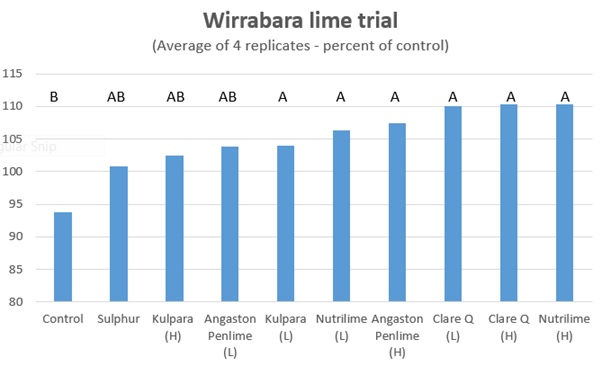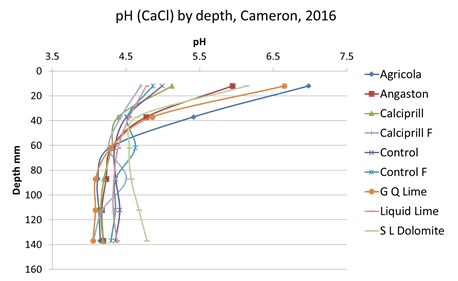Soil acidity and arresting the impact of this yield thief
Author: Brian Hughes (PIRSA Rural Solutions), Tim Herrman (Department of Environment, Water and Natural Resources) and Andrew Harding (PIRSA Rural Solutions). | Date: 07 Feb 2017
Take home messages
- The extent and severity of soil acidity are increasing under high yielding continuously cropped farming systems.
- When acidity emerges in high value sensitive crops such as lentils or faba beans, it often follows a patchy distribution which can be diagnosed and treated.
- There are some new trials comparing the effectiveness of liming products.
- New decision support tools have been developed to assist in comparing treatment options and understanding the economic impacts of acidity.
Background
Soil acidification is a major threat to soil health and crop and pasture production. The extent and severity of soil acidity are increasing with naturally acid soils becoming more acidic and naturally neutral soils with alkaline subsoils acidifying in the surface layers.
Soil acidification is a natural process, but the rate of acidification is increasing due to higher rates of nitrogen (N) fertiliser and increased cropping/hay intensity and yields. Acidification of sub surface (10-20cm) soil layers has increased which is more difficult to treat.
Soil acidification has been associated with a decline in soil health, particularly soil biota, including worms and rhizobia, issues with leaching, and tie-up of some soil nutrients and the release of toxic compounds including aluminium which affect root growth.
Identified barriers for growers to treating soil acidity include a lack of general awareness (particularly of subsurface acidification), lack of readily available information on liming products and options, and concerns about the cost and economic returns from liming, and the possibility of inducing trace element deficiencies, increasing snails or certain weeds.
Current projects
A number of projects have been developed with farming systems groups and the Agricultural Bureau of South Australia, Landcare groups, industry organisations (GRDC) and various regional Natural Resource Management Boards, Department of Environment, Water and Natural Resources (DEWNR), PIRSA and the Australian Government to explore issues and opportunities for improved treatment of soil acidity. Activities include increasing awareness and knowledge of landholders, agricultural merchants and consultants, soil testing, development and trialling of new liming sources, and the development of various computer based tools.
Results
Extent of acidity in SA
Areas prone to soil acidity include the historical higher rainfall grazing areas in SA covering much of the Mount Lofty Ranges, Lower South East (SE) and Kangaroo Island, emerging areas in the mid to high rainfall cropping areas including Lower Eyre Peninsula (LEP), Mid North and the Upper SE.
An estimated 2.1 million hectares are now considered prone to acidification of soil to below pHCa (pH measured in 0.01M CaCl2 extract) 5.5. Improved land use mapping has enabled more accurate determination of future acidic areas. Assuming current practices continue, it is estimated that acidity defined by the potential pHCa <5.5 will develop over an additional 3 million hectares over the next 10 to 50 years.
Examples of acidification
Two examples from monitoring of some long term sites are presented in Figures 1 and 2. In both cases, these highlight acidification of topsoil layers over the past 7 to 8 years, under intensive cropping.

Figure 1. pH change under ironstone soil LEP. Figure 2. Acidification under clayed sand SE.
Rates of acidification
Initial rates of acidification were largely developed from work by Richard Merry, CSIRO who compared pH change between the 1970s and 1990s. More recent sampling has indicated there is possibly a higher acidification rate again as indicated in Table 1 where high yielding, high N systems with high rainfall or some leaching possibly have an annual acidification rate of around 350kg lime per annum.
Table 1. Typical rates of annual acidification (Merry, R and Masters, B pers. comm.).
| Land Use | Mean Annual Acidification Rate Kg lime/ha/yr |
|---|---|
| Low intensity grazing | 30 |
| Medium intensity grazing - some hay cuts | 100 |
| High intensity grazing | 150 |
| Cropping pasture rotation | 100 |
| Intensive cropping - some pasture, high N inputs | 200 |
| Mostly continuous cropping - high N inputs | 250 |
| Continuous cropping - high N, leaching years | 350? |
Subsurface pH
Sub surface acidity refers to acidification of soil layers below the 0-10cm layer. This is an emerging problem and more difficult to treat than surface layers. Subsurface pH often develops where the surface pH is less than 5.0 for some period of time. Treatment options are being compared in a new trial site to be established this year but evidence from other states suggest large lime applications to the surface and incorporation is the most economic approach.
Plant tolerance/ critical pH
As a generalisation, tolerant plants become affected by acidity around pHCa 4.5; sensitive plants around 4.8-5.0 and very sensitive around 5.0-5.5. The level of aluminium dictates the impact on non-legume species, while for legumes the pH effects on rhizobia are very important, as well as aluminium. Table 2, modified from Brett Upjohn, 2005 NSW, has some broad categorisation of plants to sensitivity.
Table 2. Sensitivity to acidity.
| Highly sensitive | Durum wheat, most barley cultivars, faba beans, lentils, chickpeas, lucerne, medics, strawberry clover |
|---|---|
| Sensitive | Some wheats, canola, phalaris, red clover, Balansa clover |
| Tolerant | Wheats, annual and perennial ryegrass, tall fescue, Haifa white and subterranean clovers |
| Highly tolerant | Lupins, oats, triticale, cereal rye, cocksfoot, kikuyu |
Wheat tolerance probably depends on where the development has occurred with SA wheats generally less tolerant than those from NSW and WA (Wheeler R, SARDI pers. comm.).
Lime trials
Two new trials have been established in SA to compare newer liming products with older products and given Nutrilime is no longer available. These trials are located at Tungkillo on a thick sand over clay and Wirrabara on an acidic loam over clay.
Both trials have shown responses to lime two years after application under no till cropping. There was no response in year 1 which is not surprising given most lime products are only slightly soluble.
Figure 3 shows the responses at Wirrabara to different limes and rates two years after application and Figure 4 highlights the movement of lime products into the soil after two years at Tungkillo. In both examples, the higher quality limes seem to be having more impact on yield and changes to pH.

Figure 3. Wirrabara lime trial yield comparison 2016 Compass barley. (H-6t/ha, L-3t/ha rate modified to 100% Neutralising Value).

Figure 4. Movement of lime into soil, Tungkillo, 2016, two seasons after lime applied (6t/ha).
Liming quality
A range of tests have been developed to measure lime quality in terms of its effectiveness in counteracting soil acidity. These include the purity (termed Neutralising Value (NV)), fineness (from Effectiveness Neutralising Value or particle size), and calcium and magnesium content. Registered agricultural lime suppliers are required to provide a laboratory analysis of the NV, particle size and calcium and magnesium content of their liming products to purchasers.
Using a scanning electron microscope, CSIRO researchers have found that some lime products have much larger surface area and porosity and potential reactivity. These include those formed from coral which have a ‘honey comb’ particle structure that greatly increases the surface area and its effectiveness. Mount Gambier limestone is one such liming material. Other products such as lakebed products are dispersive and break into small particles when applied, which also increases their effectiveness.
Precision pH mapping
The Department of Primary Industries and Regions, SA and the National Landcare Program, along with private providers/contractors have invested in the validation and demonstration of technologies for paddock scale precision pH testing. By using machines and producing accurate paddock scale pH maps, growers can apply targeted lime rates, varied according to pH zones.
Decision support tools
Several decision support tools/computer models have been developed to assist landholders and advisers to make better decisions for treating soil acidification. An auditing tool enables landholders to determine approximate acidification rates on their paddocks given soil conditions, crop rotations and yield and fertiliser inputs. Other tools evaluate the impact of acidification on production (cost of not liming) and compare costs of different liming products. These tools and technologies help deliver more cost effective solutions, leading to greater adoption of strategies for managing acidic soils.
The GRDC funded project supports all components of the projects (RSS00010) and a new subsoil acidity treatment options trial has been funded by GRDC to be established (DAW00236). The SA project is linked nationally through Chris Gazey in WA.
Conclusion
The extent and severity of soil acidity are increasing across the cropping areas of SA. Poor performing patches in high value crops are often a first sign. Trials comparing new lime sources are showing promising results under no till cropping. Tools are available to help manage soil acidity.
Useful resources
Acidity website
Agricultural Bureau of South Australia website
The Soil Quality website
Enviro Data SA website
References
See acidity website
Acknowledgements
The research undertaken as part of this project is made possible by the significant contributions of growers through both trial cooperation and the support of the GRDC - the author would like to thank them for their continued support.
Soil acidity projects have been funded through the Australian Government, DEWNR, PIRSA and NRM. Acknowledgement is made of Craig Woolford and Bill Cameron for the assistance with lime trials.
Contact details
Brian Hughes
Nuriootpa Research Centre, Box 245 Nuriootpa, SA 5355
0429691468
brian.hughes@sa.gov.au
GRDC Project Code: RSS00010,
Was this page helpful?
YOUR FEEDBACK
